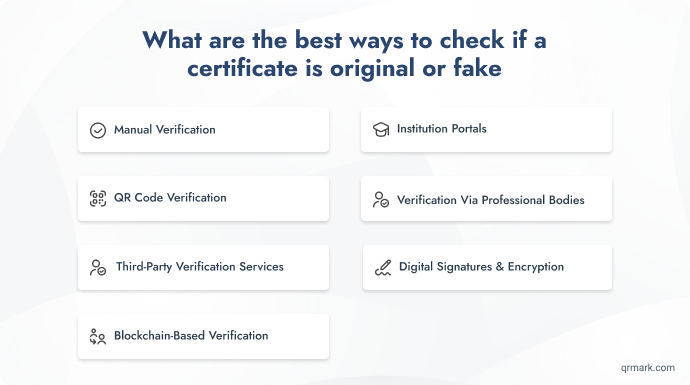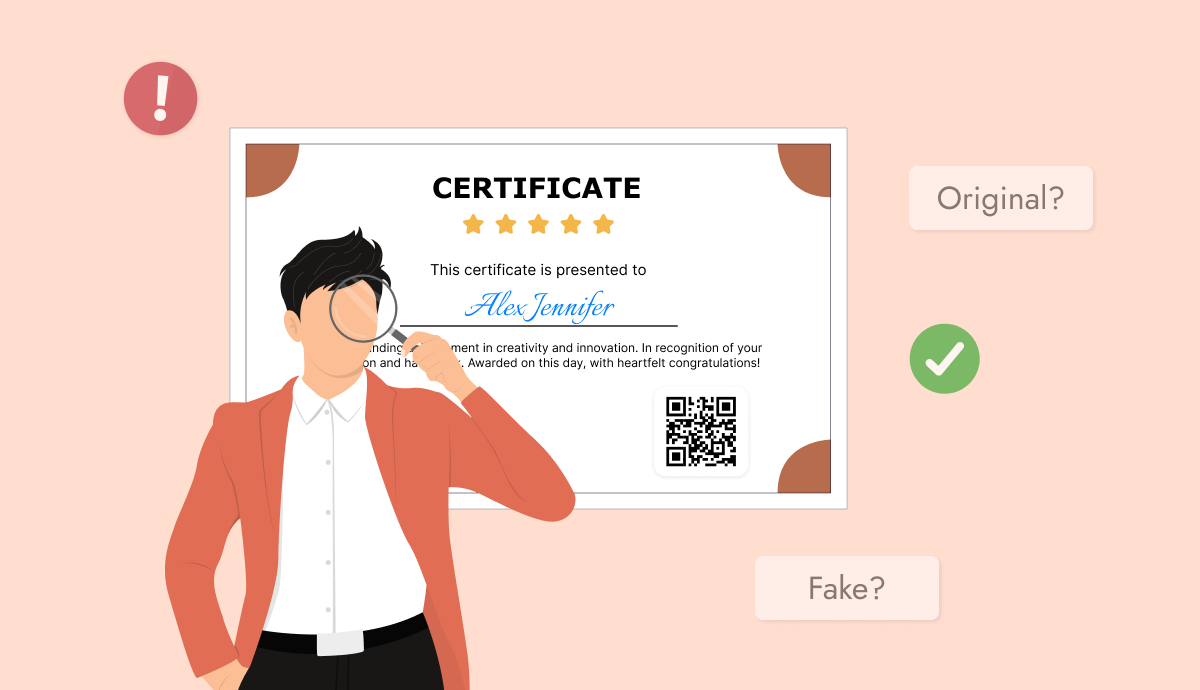TL;DR:
- To check if a certificate is real or fake online, start by identifying whether it can be verified through official channels, such as the issuing institution’s website or a recognized verification portal.
- If the certificate has a QR code, scan it to see if it links to a secure, official page. Otherwise, manually verify by contacting the institution using contact details from their official site.
- Look out for red flags like poor print quality, inconsistent fonts, outdated logos, typos, and missing security features such as watermarks or seals. Certificates that are digital-only (like PDFs) are especially easy to forge, so don’t rely on visuals alone.
The fake degree industry is exploding. According to Eaton and Carmichael, it jumped from US$1 billion in 2015 to over US$22 billion by 2022, driven by demand, low risk, and easy access to design tools.
With AI and online generators making fake certificates look more convincing than ever, it’s becoming harder to spot the difference.
Whether you’re an employer, educator, or just trying to protect yourself, knowing how to check if a certificate is original or fake is now a must.
In this guide, I’ll break down the most effective ways to tell what’s real and what’s not.
Let’s dive in!
A. What’s the difference between an original and fake certificate?
| Aspect | Original Certificate | Fake Certificate |
| 1. Basic Definition | Issued by authorized institutions with proper verification systems | Created without authorization using design software |
| 2. Security Features | Contains watermarks, QR Codes, holograms, special paper, official seals | Missing or poorly replicated security elements |
| 3. Verification | Can be verified through official channels and databases | Either cannot be verified or leads to fake systems |
| 4. Design Quality | Professional printing, consistent fonts, accurate logos | Contains errors, inconsistent formatting, poor quality |
B. Why are more people using fake certificates in 2025

Here’s what’s making fake certificates more common than ever:
1. Explosion of online learning platforms
Online education has made digital certificates the norm. These are way easier to fake than traditional physical diplomas.
Physical certificates had security features like special paper and embossed seals. Whereas most digital certificates are just PDFs, anyone can edit.
2. Remote hiring and global recruitment
As companies hire across borders, especially after COVID-19, it’s harder to verify credentials, and fake certs slip through more easily.
3. Low enforcement and consequences
Most regions don’t have strict regulations or enforcement mechanisms against presenting fake credentials, so the risk of punishment remains low.
4. AI and Design tools simplify forgery
Tools like Canva and Photoshop are now accessible to everyone, while AI can generate realistic logos and signatures automatically.
A convincing fake certificate can be created in under an hour without design expertise.
5. Scams and diploma mills are more sophisticated
Fake “institutes” now have polished websites, fake alumni networks, and even verification systems. This makes it harder to tell real from fake.
C. What are the red flags of a fake certificate?

Before you start looking into actual verification, here are some red flags that’ll tell you straight away, just by looking, that the certificate is probably fake. You don’t need tools or money for this.
1. Visual red flags
a. Poor print quality
Usually the first giveaway. If the text looks blurry or the colors seem off, it’s likely something printed on a home printer rather than professional equipment. Real certificates use high-end printing that gives clean, crisp results.
b. Logo problems
Fraudsters often pull logos straight from Google Images, which means they can be outdated, slightly off in color, or just wrong. I’ve seen fakes using logos from companies that rebranded years ago.
c. Weird paper choices
This should raise eyebrows immediately. Legit certificates aren’t printed on regular copy paper or glossy photo stock.
Most institutions use specific paper with a certain weight and texture; it should feel substantial in your hands.
d. Missing security features
Most modern certificates include things like watermarks, holograms, embossed seals, or special inks, all of which are expensive and difficult to replicate.
2. Content red flags
a. Spelling and grammar mistakes
Real institutions have multiple people reviewing these documents before they go out. If you spot typos, especially in the institution’s own name, that’s a major red flag.
b. Wrong institutional details
This happens when fraudsters don’t do their homework. Check whether the address, contact info, or even the institution’s name matches what’s currently listed on their website. Fakes often use outdated or completely incorrect details.
c. Date problems
These can be subtle but telling. Graduation dates that don’t match typical academic calendars, or signatures from people who weren’t even employed at the time, are strong indicators of a fake.
d. Sketchy verification instructions
This should immediately make you pause. If the only way to verify a certificate is through a random email or personal phone number, that’s not how any legitimate institution operates.
3. Digital Red Flags
a. Unsecured websites
Any verification link that starts with “http://” instead of “https://” is transmitting data without encryption, something no legitimate institution would be doing in 2025.
b. Suspicious web addresses
These often try to look official but have subtle differences. Watch for misspelled institution names, odd domain extensions, or URLs that just feel off compared to the real site.
If it’s genuine, the verification page should either live on the institution’s actual website as a path URL or exist as a clearly branded subdomain.
c. Broken verification systems
This could point to poor maintenance or outright fraud. Real institutions take their credibility seriously and ensure their verification portals are always up and running.
d. Tampered QR codes
Some fakes use QR codes that have been slapped on later, either covering up a real one or added to make the certificate look official.
The placement should feel intentional and built into the design, not like an afterthought.
D. What are the best ways to check if a certificate is original or fake

1. Manual verification
Reach out to the issuing institution directly using contact details from their official website. Confirm the certificate number, issue date, signatories, and any stamps or seals against their internal records. Whenever possible, use phone verification; it’s harder to fake than email.
Pros: Most reliable method with official confirmation
Cons: Time-consuming, may require follow-ups
2. Institution portals
Many reputable universities and organizations have dedicated portals where you can enter the graduate’s name, graduation year, and certificate number to get instant verification.
Pros: Official source, fast results, available 24/7
Cons: Not all institutions have portals; older records may not be digitized
3. QR Code verification
Modern certificates often include QR codes linked to verification databases. Scanning them with a smartphone should take you to a secure institutional page showing certificate details. Authentic codes lead to HTTPS sites with proper branding and matching records.
How it works:
Institution generates an encrypted QR code → Scanning links to their secure database → Real-time verification is displayed
Pros: Instant, smartphone-friendly, difficult to forge, pocket-friendly, secures both paper documents and digital files.
Cons: Needs internet connection to work
4. Verification via professional bodies
Certification providers like Microsoft, accounting boards, or medical councils usually offer searchable databases where you can check the validity, issue dates, and standing of a credential.
Pros: Official source, shows current status and history
Cons: Limited to certain professions or certifications
5. Third-party verification services
There are commercial services that handle background checks and credential verification, often used by employers. Many offer API integrations for bulk or automated processes.
Pros: Saves time, scalable for organizations
Cons: Costs involved; accuracy depends on the service provider
6. Digital signatures & encryption
Many digital certificates include cryptographic signatures that can be verified using software like Adobe Reader. A valid signature shows the certificate hasn’t been altered and confirms the issuer’s identity via a trusted Certificate Authority.
Pros: Tamper-proof, legally valid, instantly verifiable
Cons: Requires compatible software; not widely adopted yet
7. Blockchain-based verification
Some modern institutions issue certificates on blockchain, creating a permanent, timestamped, and tamper-proof record. These can be verified globally without needing to contact the issuer.
How it works:
Scan a QR code or enter the certificate ID → The system checks the blockchain ledger → A detailed verification report appears instantly
Pros: Immutable, globally accessible, doesn’t rely onan institution
Cons: Still emerging, requires basic technical understanding, needs internet connection to work
E. How to make a certificate verifiable online using QR Codes

After weighing the pros and cons of different verification methods, it’s clear that digital options like QR codes are the future.
They’re faster, cheaper than things like holograms or embossed seals, and they allow for instant, remote verification.
If you’re looking to add a verification QR code to your certificate, here’s a simple step-by-step process:
Step 1: Design your certificate
Before anything else, make sure your QR code is ready beforehand so you can include it in the design itself. You can use tools like Canva, Photoshop, Word, or any design software you’re comfortable with.
Tip: Reserve a clear space for the QR code. It shouldn’t be so large that it throws off the layout or so small that it’s hard to scan.
Step 2: Sign up on QR Mark
Head over to qrmark.com and create an account. This will give you access to their dashboard where you’ll manage verifications and QR code generation.
Step 3: Link your custom domain
You’ll need to connect your account to a custom domain that reflects your brand or institution. For example, if your main site is school.com, your certificate verification domain could be cert.school.com. This makes the QR code more trustworthy since it leads to a recognizable, authenticated subdomain.
Go to the Settings section, enter your custom domain, and complete the one-time domain verification process.
Note: This step is what separates legitimate certificates from fake ones, only you can generate QR codes that resolve to your verified domain.
Step 4: Add the verification QR Code
QR Mark gives you three flexible ways to add the code, depending on your workflow:
- Add-ons (for live creation)
If you’re building certificates from scratch, you can install QR Mark add-ons in Microsoft Office (Word, Excel, PowerPoint) or Google Workspace (Docs, Sheets, Slides). This lets you embed the QR code directly while designing.
- Dashboard upload (for existing certificates)
Already have your certificates ready in PDF format? No problem.
Go to Verification > Create Verification > Upload PDF > Select your custom domain > Generate QR image.
You can resize and place the QR code exactly where you want it. Once done, hit Confirm Placement and download the updated certificate.
- Bulk generation (for multiple certs)
I personally recommend going with the bulk generation method if you’re handling more than one certificate. You can upload up to 20 PDF files at once and add QR codes to all of them in one go.
Simply select all your PDFs, choose QR placement, and it will auto-generate codes and embed them across all files.
Step 5: Test the QR Code
Before sending out any certificate, scan the QR code yourself to make sure it’s working properly and leads to the correct verification page.
F. What are the most commonly faked types of certificates?

1. Educational certificates
Degrees, diplomas, and transcripts are often forged since they open doors to jobs. Online education growth has made digital certificates easier to replicate than traditional parchment documents.
2. Professional Certifications
High-value certs like AWS, Microsoft, Cisco, CPA, and CFA are frequent targets. That’s because they boost salaries and fast-track careers, making them a tempting shortcut for many.
3. Government-Issued Certificates
Birth, income, caste, and other eligibility documents are faked to access benefits or reservations. Slow and patchy verification processes make this easier to pull off.
4. Business Registration & Compliance Certs
Corporate licenses, ISO certifications, and industry accreditations help fraudulent companies appear legitimate to clients and partners.
5. International Certifications
Language tests (TOEFL, IELTS) and overseas professional certificates are forged for immigration or jobs abroad, especially where cross-border checks are weak or delayed.
G. Frequently Asked Questions
1. How can I verify a certificate if the institution doesn’t have an online portal?
Contact the institution directly using official contact information from their website. Phone verification is more reliable than email.
You can also check if they’re listed with relevant accreditation bodies or professional associations that maintain their own verification databases.
2. Are QR codes on certificates always authentic?
Not necessarily. QR codes can be faked or tampered with. Always check that the QR code leads to the official institution’s website (look for proper HTTPS and matching domain names).
Legitimate QR codes should integrate naturally into the certificate design, not look like they were added later.
3. How long does certificate verification typically take?
It varies by method. QR codes and online portals verify instantly. Manual verification through institutions can take 1-5 business days.
Third-party verification services usually take 2-7 days. Blockchain verification is instant but not widely available yet.
4. Can old certificates be verified if the institution has closed down?
This can be challenging. Check if another institution took over their records, or contact the relevant education department or accreditation body.
Some closed institutions transfer their records to government databases or successor organizations.
5. Is it legal to verify someone else’s certificate?
Generally yes, if you have a legitimate reason (like employment verification) and the person’s consent. However, privacy laws vary by region.
Always ensure you’re complying with local data protection regulations and only verify certificates when you have proper authorization.
H. Conclusion
Certificate verification is becoming increasingly important as fraud techniques become more sophisticated.
Always use multiple verification methods rather than relying on visual inspection alone. Start with obvious red flags, then use digital verification tools like QR codes or institutional portals.
For important decisions, contact the issuing institution directly for confirmation. The key is staying vigilant and understanding that a professional-looking certificate doesn’t guarantee authenticity.



Leave a Reply